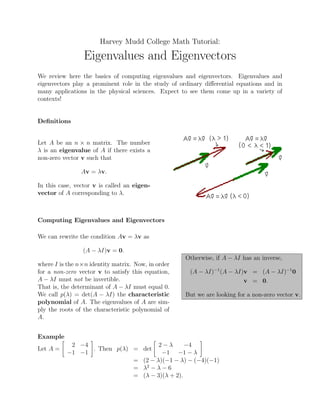
Eigenstuff
- 1. Harvey Mudd College Math Tutorial: Eigenvalues and Eigenvectors We review here the basics of computing eigenvalues and eigenvectors. Eigenvalues and eigenvectors play a prominent role in the study of ordinary differential equations and in many applications in the physical sciences. Expect to see them come up in a variety of contexts! Definitions Let A be an n × n matrix. The number λ is an eigenvalue of A if there exists a non-zero vector v such that Av = λv. In this case, vector v is called an eigen- vector of A corresponding to λ. Computing Eigenvalues and Eigenvectors We can rewrite the condition Av = λv as (A − λI)v = 0. Otherwise, if A − λI has an inverse, where I is the n×n identity matrix. Now, in order for a non-zero vector v to satisfy this equation, (A − λI)−1 (A − λI)v = (A − λI)−1 0 A − λI must not be invertible. v = 0. That is, the determinant of A − λI must equal 0. We call p(λ) = det(A − λI) the characteristic But we are looking for a non-zero vector v. polynomial of A. The eigenvalues of A are sim- ply the roots of the characteristic polynomial of A. Example 2 −4 2−λ −4 Let A = . Then p(λ) = det −1 −1 −1 −1 − λ = (2 − λ)(−1 − λ) − (−4)(−1) = λ2 − λ − 6 = (λ − 3)(λ + 2).
- 2. Thus, λ1 = 3 and λ2 = −2 are the eigenvalues of A. v1 v2 To find eigenvectors v = . . corresponding to an eigenvalue λ, we simply solve the system . vn of linear equations given by (A − λI)v = 0. Example 2 −4 The matrix A = of the previous example has eigenvalues λ1 = 3 and λ2 = −2. −1 −1 Let’s find the eigenvectors corresponding to λ1 = 3. Let v = v1 . Then (A − 3I)v = 0 gives v2 us 2−3 −4 v1 0 = , −1 −1 − 3 v2 0 from which we obtain the duplicate equations −v1 − 4v2 = 0 −v1 − 4v2 = 0. If we let v2 = t, then v1 = −4t. All eigenvectors corresponding to λ1 = 3 are multiples of −4 1 and thus the eigenspace corresponding to λ1 = 3 is given by the span of −4 . That is, 1 −4 1 is a basis of the eigenspace corresponding to λ1 = 3. Repeating this process with λ2 = −2, we find that 4v1 − 4V2 = 0 −v1 + v2 = 0 1 If we let v2 = t then v1 = t as well. Thus, an eigenvector corresponding to λ2 = −2 is 1 1 1 and the eigenspace corresponding to λ2 = −2 is given by the span of 1 . 1 is a basis for the eigenspace corresponding to λ2 = −2. In the following example, we see a two-dimensional eigenspace. Example 5 8 16 5−λ 8 16 Let A = 4 1 8 . Then p(λ) = det 4 1−λ 8 = (λ − 1)(λ + 3)2 −4 −4 −11 −4 −4 −11 − λ aftersome algebra! Thus, λ1 = 1 and λ2 = −3 are the eigenvalues of A. Eigenvectors v1 v = v2 corresponding to λ1 = 1 must satisfy v3
- 3. 4v1 + 8v2 + 16v3 = 0 4v1 + 8v3 = 0 −4v1 − 4v2 − 12v3 = 0. Letting v3 = t, we find from the second equation that v1 = −2t, and then v2 = −t. All −2 eigenvectors corresponding to λ1 = 1 are multiples of −1 , and so the eigenspace corre- 1 −2 −2 sponding to λ1 = 1 is given by the span of −1 . −1 is a basis for the eigenspace 1 1 corresponding to λ1 = 1. Eigenvectors corresponding to λ2 = −3 must satisfy 8v1 + 8v2 + 16v3 = 0 4v1 + 4v2 + 8v3 = 0 −4v1 − 4v2 − 8v3 = 0. The equations here are just multiples of each other! If we let v3 = t and v2 = s, then v1 = −s − 2t. Eigenvectors corresponding to λ2 = −3 have the form −1 −2 1 s + 0 t. 0 1 −1 Thus, the eigenspace corresponding to λ2 = −3 is two-dimensional and is spanned by 1 0 −2 −1 −2 and 0 . 1 , 0 is a basis for the eigenspace corresponding to λ2 = −3. 1 0 1 Notes • Eigenvalues and eigenvectors can be complex-valued as well as real-valued. • The dimension of the eigenspace corresponding to an eigenvalue is less than or equal to the multiplicity of that eigenvalue. • The techniques used here are practical for 2 × 2 and 3 × 3 matrices. Eigenvalues and eigenvectors of larger matrices are often found using other techniques, such as iterative methods.
- 4. Key Concepts Let A be an n×n matrix. The eigenvalues of A are the roots of the characteristic polynomial p(λ) = det(A − λI). v1 v2 For each eigenvalue λ, we find eigenvectors v = . . by solving the linear system . vn (A − λI)v = 0. The set of all vectors v satisfying Av = λv is called the eigenspace of A corresponding to λ. [I’m ready to take the quiz.] [I need to review more.] [Take me back to the Tutorial Page]